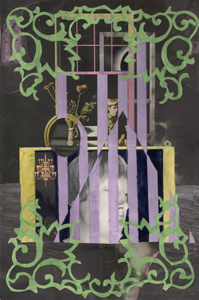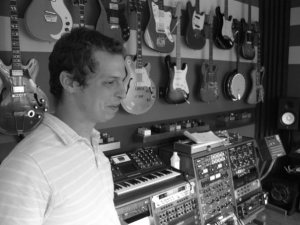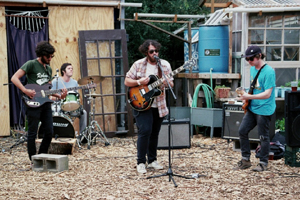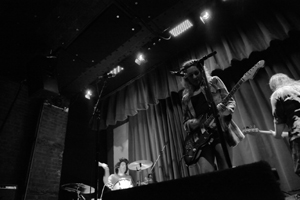Behind the Making of “Brooklyn Heat”: Recording Six of BKYLN’s Finest in Six Days
GREENPOINT, BROOKLYN: When it’s this cold outside, huddling up together makes perfect sense. With this week’s release of Brooklyn Heat – a collection of singles recorded by six BKLYN indie bands in six days last summer – we can all hope to feel the searing goodness of NYC rock and roll come shooting through our speakers.
Interestingly, Brooklyn Heat’s helmsman, Producer/Engineer Shane O’Connor, had to warm up to the idea of making a compilation. But the offer of free studio time from Monsterland Recording Studio (now RIP) proved impossible for this hard-core recordist to refuse, and that’s a good thing.
When the collection officially launches this Thursday night (1/20) with a party at Greenpoint’s COCO 66, people are bound to hook onto what they hear. Each Brooklyn Heat band – Quiet Loudly, Gunfight!, Shark?, Quilty, Little Racer, and Magnetic Island – make their own urgently artful contribution to the comp. The rock here is as compelling, raw and real as it is well-recorded.
For music producers, engineers and artists who are as interested in how to capture a concept as they are in overdubbing a Clavinet, the machinations behind Brooklyn Heat are worth knowing.
How did the idea for Brooklyn Heat come together?
I was approached by Bones Howell (his stage name, he specifically asked me to not use his given name), the owner of Monsterland Recording Studio about working out of his studio in the winter of 2010. I did a few projects out of his studio but I had other studios around NYC and Boston that I was working at as well. His studio was more of an overgrown — and built out — project studio with great gear.
Monsterland existed for about six years in various forms and he was tired of running the studio as a commercial venture — I owned a studio for three years in Boston and I can completely understand why owning a commercial facility can be frustrating.
Bones asked me if I would be interested in some free studio time to work on a project outside of the typical confines of a commercial recording. He suggested a compilation project, but my reaction was lukewarm at best: To me, a compilation was something that ska bands from 1997 put together. It was rarely, if ever, seen as a comprehensive work and was usually meant for the purpose of selling a larger product like an album or a touring bill.
I thought about the proposition more, and I decided that a compilation in the year 2010 didn’t need to be for the purpose of commerce at all if I didn’t want it to be. With this opportunity of free studio time from Monsterland, I could create a meaningful body of work outside of commerce that was purely for the promotion and proliferation of the artist. With this goal in mind, Brooklyn Heat was born.
That’s an organic genesis – the best kind. How did you select which bands would be involved? And with the sometimes questionable nature of compilations, why do you think this was something they wanted to be a part of?
The primary factor in choosing artists for Brooklyn Heat was my personal interest in their work. I had to really dig what they were doing, and their potential in the future for selection in this project. I also wanted the artists to know each other. There are a multitude of micro scenes in Brooklyn and I wanted to highlight a moment of “rock” in the summer of 2010.
Through the filter of my personal interest and selecting artists from the same social circle, there’s a cohesive sound to Brooklyn Heat that I was not initially intending, but I think its the most significant part of the project.
The project’s sound happens to be fast, somewhat punky, and largely stripped down. For the bands that I picked, there was an effort to stay away from things that are often indulged in with home recordings such as wild effects and endless layers of keyboards. The record is more about capturing bands in a moment that an inserted production aesthetic.
You definitely get that. The bands each have their own sound, but there’s a clear common thread between all of them as well. So how did Monsterland work out as the studio for the project?
Unfortunately that studio is now closed, but I hope to do similar projects in the future. I’m not sure where yet, but I’m sure someone I know will throw me some studio time for another venture like this! But Monsterland happened to be well equipped to record a rock band in a live setting, which is how most of this project was recorded.
The Brooklyn Heat Website says that you recorded six bands in six days. Was it tough to work this way? On the other hand, what are the benefits of recording a band-a-day?
The press releases all say “six bands in six days” which is partially true but also a lie. There were some mix revisions that happened outside of that time constraint, but not far beyond 10 hours per song. The time constraint was actually created by me, not by the studio owner. Monsterland’s owner would have been fine if each song took a month, but that wasn’t what I was trying to create. I think a day to record a rock song is a perfectly acceptable amount of time.
I tend to push for live recordings as opposed to an overdub method. I was trained as an engineer by very traditional producers and engineers who tried to keep recording styles of the ’60’s and ’70’s alive, and I think the time constraint adds to that aesthetic as well. I like schedules. It keeps people honest about what’s important in a recording.
The workflow was very casual since there wasn’t a dollar sign attached to the clock. Each band cut basics before lunch and then we would cut any overdubs and vocals that were left in the afternoon. Most of the mixes were done in two hours. It’s easy when the song is good and everyone is relaxed.
For recording equipment, most of our tools were rather standard: We had a Pro Tools HD1 rig with a Lynx Aurora 16 box, and I mixed mainly in the box with a Dangerous Summing Buss on the back end, and I had some nice compressors on crucial elements such as kick, snare, vocals, bass — I had an LA-2A, two 1176’s, and a Distressor. Those all helped, but because the dynamics of the performances were on I opted for a lot of group compression with plugins. I like those Stillwell Audio plugins a lot.
Throughout the entire record I was testing the ADK S-7 and A-6 microphones for a review. I usually don’t test gear in actual recording sessions, but for this project I felt it was appropriate. They are nice mics.
Sounds like an uncomplicated workflow, which is totally appropriate for the project. Was there a song from the bunch that you really enjoyed capturing?
The Gunfight! cut (“I Would Be Your Man”) was probably my favorite song to record for this project. On this song, members of Quiet Loudly lent a hand with some guitar solos, and backing vocals. Both bands share the same bass players so there was this weird incestuous quality about the creation of that song that felt like I was really capturing something special. Gunfight! and Quiet Loudly were on tour together all summer so they had all kinds of unspoken chemistry that I had to tap into very quickly.
On a usual record I may have a month or more to develop relationships within a band so that once we’re in a studio, I understand who’s the boss, who’s the diva, and who’s the “recording guy”. With Brooklyn Heat I had to discover individual roles in ten minutes.
Even though you had your own doubts before getting started, I’d say overall that producers, engineers, studios and artists seem increasingly interested in creating compilations like this, where there’s a common thread to how the record is produced/created/etc… What’s the attraction of doing a focused project like Brooklyn Heat — what makes it good for everyone involved?
It’s great for the artist — specifically with this project — in that they’re given a platform to create without the financial constraints that the “recording industry” typically puts in place.
For me, it was a way to do what I love without a lot of the downsides put into place by the financial reality of recording. I can only hope that it shines a positive light on the artists I am showcasing. An added benefit would be recognition of my engineering work, but that is not really the intention of the project.
Hopefully, for our intended audience it’s a document of a time in Brooklyn rock.
Those are admirably modest — yet somehow lofty — goals. For you, what’s the particular draw of documenting, and being a part of, the NYC audio scene right now?
I lived in Boston working as a producer and an engineer for six years, and the scene is great there. NYC in comparison has a commitment to create something special. People move here from all over the world to create a new thing — from that perspective I think it is an ideal place to live and work in music.
The flip side is that it’s expensive, dirty, and competitive. Most cities are. I would rather record some awesome bands in NYC and spend less money than record more less-inspired bands in Rochester or something. I’m not saying that one has to live in NYC or Nashville to “make it” — but it is certainly easier.
Here here. You definitely seem to have some righteous influences going. Who’s inspired you to approach producing and engineering the way that you do?
Although I don’t make records like his, Phil Elvrum (Mount Eerie, The Microphones) has always interested me. People put a “producer” cap on him, but I think of him as more of a songwriter put into a recordists chair out of necessity. He was given solid tools to work with well before the home recording thing got big, and he made the most out of what he had.
Fast forward ten years, most 14-year-old kids with a laptop have access to what he had, and yet you don’t see those 14-year-old kids with the Dr. Dre laptop/headphone bundle creating lush atmospheric and dramatic productions like Elvrum. I think he’s a testament to creativity over gear.
Catch the Brooklyn Heat Project Launch LIVE! The show is January 20th, 8pm at COCO 66 (66 Greenpoint Ave) in – you guessed it – Brooklyn, NYC. All of the bands on the bill are on the compilation, including Quietloudly/ Gunfight (collaborative performance), Shark?, Quilty, Little Racer, and Magnetic Island.
— David Weiss
Please note: When you buy products through links on this page, we may earn an affiliate commission.











Quietloudly/Gunfight!
January 18, 2011 at 4:44 am (13 years ago)CORRECTION: GUNFIGHT! IS NOT ON THE QUIET LOUDLY SONG, BUT QUIET LOUDLY IS ON THE GUNFIGHT! SONG.
David
January 19, 2011 at 11:28 pm (13 years ago)Thanks for this! I believe its all fixed now. — The Editors